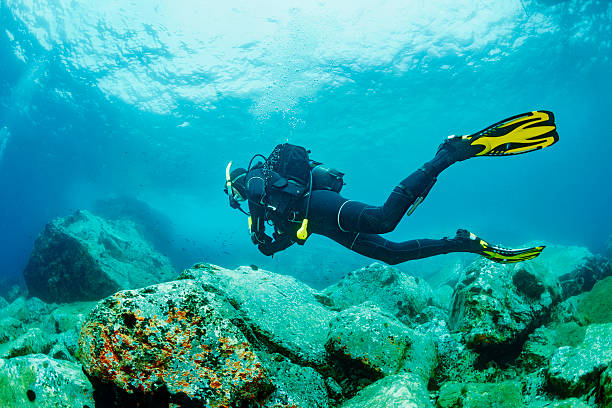Das Eintauchen in die Tiefen des Ozeans ist eine spannende Erkundung sowohl des Selbst als auch der Meeresumwelt. Dieses faszinierende Unterfangen geht über das bloße Genießen der stillen Schönheit der Unterwasserwelt hinaus. Es unterstreicht, wie wichtig es ist, die Fähigkeiten und Grenzen des menschlichen Körpers unter Wasser zu verstehen. Daher bietet dieser Artikel eine ausführliche Darstellung des Themas und beleuchtet die wesentlichen Grundlagen und Sicherheitsprotokolle.
Wie tief kann ein Mensch tauchen?

Wie tief kann man frei tauchen? Beim Freitauchen steht die Freiheit des menschlichen Körpers unter Wasser im Mittelpunkt. Die durchschnittliche Tiefengrenze für einen Freizeitsportler liegt zwischen 30 bis 40 Fuß (9 bis 12 Meter)Durch Verfeinerung der Technik und Atemtraining können diese Werte jedoch übertroffen werden. Die Beherrschung von Druckausgleichstechniken, disziplinierte Yoga-Übungen und gezielte Trainingsprogramme können das menschliche Potenzial in dieser Hinsicht steigern.
Was ist Tauchen?

Per Definition ist Tauchen das Abtauchen unter die Wasseroberfläche, um mit der aquatischen Umwelt zu interagieren. Es gibt verschiedene Arten des Tauchens, die sich durch den Kontext und die verwendete Ausrüstung unterscheiden – von Gerätetauchen, mit Sauerstoffflaschen auf dem Rücken, um Freitauchen, bei dem es ausschließlich auf der Fähigkeit des Patienten beruht, den Atem anzuhalten. Sporttauchen, technisches Tauchen, Höhlentauchen und kommerzielles Tauchen ist Teil des breiten Spektrums.
Jede Tauchart erfordert eine eigene Ausrüstung. Standard Tauchausrüstung beinhaltet eine Tauchermaske für die Sicht, Flossen zur Navigation, ein Tauchanzug zur Temperaturregulierung und ein Tarierwesten zur Tiefenkontrolle. Beim Gerätetauchen umfasst dies auch Atemgeräte wie Atemregler und Tauchcomputer.
Die Tiefengrenzen des Menschen verstehen

Physiologische und psychologische Faktoren bestimmen die Grenzen des menschlichen Tiefentauchens unter Wasser. Der erhöhte Wasserdruck beim Abtauchen beeinflusst die Tarierungskontrolle und stellt verschiedene physiologische Herausforderungen dar, darunter Stickstoffnarkose Und Dekompressionskrankheit– Zustände, die durch die Ansammlung und Freisetzung von Gasen im Körper unter wechselnden Druckverhältnissen entstehen. Auch psychische Zustände wie Panik, Angst oder Verwirrung eines Tauchers können zu Tauchunfällen beitragen.
Gerätetauchen vs. Freitauchen

Es gibt eine starker Kontrast zwischen Gerätetauchen und Freitauchen über das sichtbare Fehlen von Ausrüstung in letzterem hinaus. Taucher können länger unter Wasser bleiben, größere Tiefen erkunden und mehr Ausrüstung mitführen, erfordern jedoch umfangreiche finanzielle Investitionen in Ausrüstung und technisches Training.
Freitauchen, hingegen ist eine Hommage an den natürlichen menschlichen Instinkt und das Potenzial und bietet eine intimere und ruhigere Interaktion mit dem Meeresleben ohne den Lärm von Blasen. Es erfordert jedoch außergewöhnliche körperliche Fitness, Disziplin und eine höhere Risikobereitschaft aufgrund der inhärenten Risiken des Freitauchens. Wenn Sie mehr über das Tauchen erfahren möchten, haben wir einen informativen Blogbeitrag mit dem Titel Alles, was Sie über Freitauchen wissen müssen das das Thema im Detail untersucht.
Wie tief kann man mit Tauchausrüstung tauchen?

Normalerweise entspricht das Sporttauchen einer empfohlenen Tiefenbegrenzung von 130 Fuß (40 Meter)Für technische Taucher, die eine spezielle Ausbildung, Ausrüstung und Verfahren absolviert haben, kann die Tiefe bis zu 300 Fuß (90 Meter)und sogar noch mehr. Tauchgänge tiefer als 40 Meter gelten jedoch als sehr riskant und werden nicht empfohlen.
Weltrekordtiefe im Freitauchen

Im Bereich des Freitauchens sind Weltrekorde der Höhepunkt menschlicher Unterwasserfähigkeiten. Der aktuelle Rekord für den tiefsten Freitauchgang (Kategorie Männer) liegt bei einer atemberaubenden 702 Fuß (214 Meter), gehalten von Herbert Nitsch, treffend als „der tiefgründigste Mann der Welt“ bezeichnet.
Nitschs Leistung dient aufstrebenden Freitauchern weltweit als Inspiration und zeigt das enorme Potenzial des menschlichen Körpers, seine Grenzen zu überschreiten. Man darf jedoch nicht vergessen, dass Weltrekordversuche die Grenzen menschlicher Fähigkeiten überschreiten und nur von gut ausgebildeten und erfahrenen Personen mit einem fundierten Verständnis der damit verbundenen Risiken unternommen werden sollten.
Sicherheitsmaßnahmen beim Tieftauchen

Beim Tieftauchen sind Sicherheitsprotokolle von größter Bedeutung, um das Wohlbefinden der Taucher zu gewährleisten. Die Erkundung größerer Tiefen erfordert spezielle Ausrüstung und Training, um potenzielle Risiken zu minimieren.
Bedeutung von Sicherheitsprotokollen beim Tieftauchen
Tieftauchen birgt besondere Herausforderungen und potenzielle Gefahren, denen durch etablierte Sicherheitsprotokolle begegnet werden muss. Diese Protokolle dienen als Grundlage für sicheres Verhalten und helfen Tauchern, während ihrer Unterwasserreise fundierte Entscheidungen zu treffen. Durch die Einhaltung dieser Protokolle können Taucher die mit zunehmender Tiefe verbundenen Risiken minimieren und ihre allgemeine Sicherheit erhöhen.
Erforderliche Ausrüstung und Ausbildung für das Tauchen in größeren Tiefen
Tauchen in größeren Tiefen erfordert spezielle Ausrüstung, die dem steigenden Druck standhält und mögliche Komplikationen bewältigt. Technische Taucher nutzen beispielsweise fortschrittliche Tauchgeräte wie Kreislaufgeräte, die die ausgeatmete Luft des Tauchers recyceln und so eine kontinuierliche Sauerstoffversorgung gewährleisten. Diese Geräte verlängern nicht nur die Grundzeiten, sondern ermöglichen auch sicherere Dekompressionsstopps beim Aufstieg. Typischerweise professionelle Hersteller von Schnorchel- und Freitauchausrüstung bietet marktgerechte Ausrüstungssets an. Klicken Sie hier, um mehr zu erfahren.
Neben der speziellen Ausrüstung erfordert Tieftauchen eine gründliche Ausbildung. Taucher müssen umfassende Kurse absolvieren und sich Kenntnisse in Techniken wie Gasmanagement, Dekompressionsverfahren und Notfallstrategien aneignen. Mit dem nötigen Wissen und den nötigen Fähigkeiten können Taucher die Herausforderungen größerer Tiefen sicher meistern.
Risiken und Vorsichtsmaßnahmen beim Tieftauchen
Obwohl der Reiz des Tieftauchens unbestreitbar ist, ist es wichtig, die damit verbundenen Risiken zu kennen und zu minimieren. Mit zunehmender Tiefe können Gefahren wie Stickstoffnarkose auftreten, die Urteilsvermögen und Koordination beeinträchtigen kann. Die Dekompressionskrankheit, auch Taucherkrankheit genannt, kann bei zu schnellem Auftauchen auftreten und zur Bildung von Stickstoffbläschen im Blutkreislauf führen.
Um diese Risiken zu minimieren, müssen Taucher beim Auftauchen die Dekompressionspläne strikt einhalten, damit ihr Körper überschüssigen Stickstoff allmählich abgeben kann. Regelmäßiges Training, Übung und die Aufrechterhaltung einer angemessenen Fitness sind unerlässlich, um die mit dem Tieftauchen verbundenen Risiken zu reduzieren. Darüber hinaus gewährleisten eine kontinuierliche Kommunikation und Tauchgangsplanung unter den Tauchpartnern eine effiziente Reaktion auf unvorhergesehene Umstände.
Abschluss
Bei diesem spannenden Erlebnis des Tauchens ist es entscheidend, die Grenzen der menschlichen Fähigkeiten unter Wasser zu kennen. Egal, ob Sie ein erfahrener Taucher oder ein Anfänger sind, der die Tiefen des Ozeans erkunden möchte, denken Sie an die Grundregeln des Tauchens: Planen Sie Ihren Tauchgang, tauchen Sie nach Plan und überschreiten Sie niemals Ihr Trainingsniveau. Der menschliche Körper weist eine phänomenale Anpassungsfähigkeit auf, was Tieftauchen zu einer verlockenden Aussicht macht. Trösten Sie sich jedoch damit, dass die faszinierende Faszination des Unterwasserlebens nicht auf größere Tiefen beschränkt ist, sondern bereits wenige Meter unter den Wellen beginnt. Genießen Sie die Erkundung dieser Unterwasserwunderwelten, beachten Sie dabei die Sicherheitsvorschriften und respektieren Sie Ihre persönlichen Grenzen.


